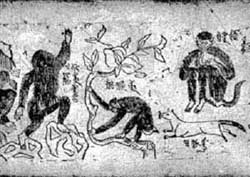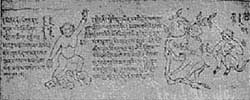Bigfoot Encounters
Diagnosis of the 'Wild Man' according to Buddhist Literary Sources from Tibet, Mongolia and China
Emanuel Vlcek with Josef Kolmaš and Pavel Poucha
I (Emanuel Vlcek) reported in the August issue of Man, 1959, 203, on some interesting old literary evidence for the existence of wild man in Mongolia, Tibet and the adjacent regions. The material was obtained by the Czechoslovak-Mongolian Archaeological Expedition in 1958. For the transliteration and transcription, free translations by Mongolian monks from Ulanbator (Urga) were used in the article. Since according to the response these materials appeared to be very important, I asked our oriental linguists who have only recently returned from abroad to make a precise transliteration and translation of the texts according to international usage (a slight modification of the Chinese Professor Yü Tao-ch'üan's system of transliteration of Tibetan was employed) in order that the texts might also serve as important research sources for linguists.
The Tibetan and the Chinese texts were translated by J. Kolmaš, the Mongolian and the Manchurian ones by P. Poucha, both from the Oriental Institute, Czechoslovak Academy of Sciences, Prague. Appended to these two sources is an extract relating to this subject and discovered only recently by J. Kolmaš in a collection of sacred Tibetan books called Kanjur. The texts accompanying the illustrations were subjected to a new precise study and read as follows:
Peking Edition
Title (transliteration):
Dri med shel phreng nas bshad pavi sman gyi vkhrungs dpe mdses mtsar mig rgyan ces bya ba bzhugs so.
Free translation:
"Gorgeously decorated book on the origin of medicinals interpreted by Dri-med Shel-phreng."
Peking Edition
Fig. 1. Peking Edition, P.24a, left
 Cut-out from p. 24a (fig. 1):
Cut-out from p. 24a (fig. 1):
First illustration (left), upright figure on a rock with upraised arm:
Tibetan: mi rgod = wild man
Chinese: p'i = bear
Mongolian: kümüun göregsü = wild man, man-animal.
Second illustration (centre), monkey on a branch:
Tibetan: sprevu = small monkey
Chinese: hou = little monkey
Mongolian: samci = monkey.
Third illustration (right), sitting monkey:
Tibetan: spre = large monkey
Chinese: yüan = monkey
Mongolian: becin = monkey.
Urga Edition
Title (transliteration):
Gso byed bdud rtzivi vkhrul med ngos vdsin bxo rig me long du rnam par shad pa mdses mtsar mig rgyan zhes bya ba bzhugs so. 1
Urga Edition
Fig. 2. Urga Edition, P.119b, third, fourth, and fifth figures from left.
 Text on the right hand of the figure (left of picture)
Text on the right hand of the figure (left of picture)
(transliteration):
Mi rgod ni, ri gnyan du gnas pavi dom rigs dbyibs mi dang mtsungs, yang rtzal stobs xa cang che bavo. Devi sha gdon la phan pa dang lxan thabs las mkhris pas mkhris pa sel bar gsungs so.
Translation:
Mi-rgod (pronounced me kö) is a creature of the bear family which lives in the proximity of the mountains and resembles man. It has very great strength. Its meat is good as a remedy against evil spirits that cause diseases. The medical book called Lhan Thab says that its gall is used to cure diseases of the gall-bladder.
Texts accompanying the illustrations:
Manchurian: šuwa nasin = wood-bear
Mongolian: kümün göregesü = wild man
Chinese: p'i = bear
Tibetan: transliteration of Chinese name.
Text related to the illustration of monkeys (right)
Transliteration:
Sprevu ni, sprevi skad yin par {bai sngon las byung) zhing yang gnyer gdong, yan lag gi dwags zhes pa rivi mivi rigs yin te, khyevu ltar ser smug spu ring gzhang la spu med cing vgro tsul yang mi dang vdra ba, shing tog la vdod che zhing meher ba med do, de las lus che spu ring mjug ring la spre, chung bar sprevu yin, {rgyud las, sprevuvi rus pas bu vbyin byed. Ces gsungs.} 2
Translation:
Sprevu (pronounced peeoo) is the sound produced by the monkey [hence its name-J.K.]. It is also called 'wrinkled face.' It is an animal with extremities, of the family of the mountain men. It resembles the dog, is of pale purple colour, with long hair. It has no hair on the rump. Its gait resembles that of man. It likes fruit, has no spleen. Those of them that have a large body, long hair and a long tail are called 'te.' Small ones are called 'peeoo.' {The Tantras say that people (sons) arose from the monkey family (bone).)
Illustration of a monkey on a branch (centre):
Tibetan: sprevu = little monkey
Chinese: hou = monkey
Manchurian: monio = yellow-monkey
Mongolian: samci = monkey.
Illustration of a sitting monkey (right):
Tibetan: spre = monkey
Chinese: yüan = monkey
Manchurian: monio = large monkey
Mongolian: becin = monkey.
Only on the basis of this precise reading and translation of the texts from the Peking and Urga editions of the pharmaceutical book is it to a certain extent possible to try to take up an attitude towards the dilemma of the 'wild man' even from the point of view of their meaning.
After reading not only the texts and names relating to the illustrations of the 'wild man,' but also those belonging to the neighbouring animals, it is possible to reach conclusions even on the zoological position of the 'wild man' in the natural system of the Tibetans. In both editions of these Buddhist textbooks the 'wild man' is always placed consistently between a group of bears which precedes him and a group of monkeys following. Already this localization in itself suggests where the 'wild man' should actually be placed in the system.
This placing by localization in the text is even emphasized by the different meanings of the translations of the names of the 'wild man' in all the languages used here. While the Tibetan and the Mongolian texts speak about a 'wild man' in the proper meaning of the word or about a 'man-animal' or both, the Chinese and the Manchurian names hint at another connexion — with the bear. Besides, the text given on the right hand of the wild man in the Urga edition directly says: "Mi-rgod is a creature of the bear family which ... resembles man."
Finally, the fact that this 'wild man' belongs neither among the monkeys nor to man may be judged from the last sentence of the text relating to the illustration of monkeys in the Urga edition. The text in free translation runs: "The Tantras say that people (sons) arose from the monkey family (bone)." This sentence can only mean that in the natural system of the Tibetans man is also placed at the highest point, following after the monkey. 3
On the basis of the above two literary documents it is possible to try to include the 'wild man' in the following zoological system: bears — wild man — monkeys — man. The Chinese and the Manchurian texts seem to sound more probable.
The illustration of the 'wild man' may even represent a certain being of no actual zoological basis, or may mean that the name of the being is reserved for a certain kind of people, such as thieves, robbers, as shown by one passage in the Kanjur.
In the Kanjur which together with the Tanjur forms the Tibetan Buddhist canon, in a section called 'Gzungs vdus' (Collection of Dhäranï), in a volume bearing the Tibetan name 'wam,' there appears on pp. 56b5-57a7 a magic formula (dhäranï in Sanskrit, gzungs in Tibetan) whose Tibetan name is:
Vphags pa mi rgod rnam par vjoms pa zhes bya bavi gzungs
Its Sanskrit model runs:
Arya- cauravhidhvamsana-nama-dharani.
The magic formula may be translated into English as follows:
"The magic sentence that secures a complete defeat of the thief."
It may thus be seen that in this case the Tibetan word 'mi rgod' was used in the sense of 'robber, thief,' 'caura' in Sanskrit. This turns the entire question of the determination of the 'wild man' in a somewhat different direction.
By these three literary sources on the existence of the wild man, Czechoslovak science contributes to the solution of this very interesting dilemma of the existence and diagnosis of the snow man. Is he a myth or a living creature?
A final evaluation will still require not only further linguistic and natural historical study, but also a good piece of luck, in order that sound and unambiguous proofs of the true nature of the at present sensation-enveloped 'snow man' may successfully be presented.
Notes
1. The translation does not make logical sense.-J.K.
2. The text marked { } is not quite clear, or the translation does not make logical sense.-J.K.
3. The Tibetans' conception of the development of man from the ape is very clearly formulated for example in a historical book called Clear Mirror of the Royal Genealogies (reported by J. Kolmaš in his article entitled 'How the Tibetans came on Earth,' New Orient Bimonthly, 1960, No. 3, p.10).
Published in "Man" - October 1960, Volume 60 Pgs: 153-155
-----
The Snowman by
C.R. Bawden
Sir, — I was especially interested in Dr. Vlcek's intriguing paper on the 'snow man' in Tibet and Mongolia as I had the pleasure of meeting Dr. Vlcek and his colleagues in Mongolia last year.
Would you permit me to offer some observations on this paper? Dr. Vlcek's readings of the manes of the creature on the two pictures in figs. 1 and 2 are rather wide of the mark. In fig. 1 the top line of script is Tibetan and reads mi-rgod. Below this we have to the left a Chinese character pronounced p'i and to the right the Mongol words kümüm görügesü. In fig. 2 the same Chinese character appears to the right, with its pronunciation (p'i-i) figured in Tibetan script below. To the left we have the same Mongol words followed by two words suwa nasim in the Manchu language. Dr. Vlcek's words samdja and bitchun (misspelling for betchin) are both Mongol words for monkey, and are attached, in Plate H, to the tree-climbing monkey and the sitting monkey appearing directly to the right of the 'wild man,' and are thus irrelevant. His 'osodrashin' looks like a corruption, as the creature in fig. 2 is actually referred to in the Tibetan text as mi-rgod, and his zerleg khoon is a modern phrase meaning 'wild man' and was possibly furnished to him by a Mongol colleague as it nowhere occurs in Plate H.
It is hard to disentangle, by searching through dictionaries, the meanings attached in various languages at different times to creatures which may turn out to be fictitious. Our 'wild man' is associated in Plate H with monkeys on the right and with bears on the left, and the names given him reflect the uncertainties as to his true nature. Tibetan mi-rgod is explained in Jaschke's dictionary as "some gigantic hairy fiend" and the Mongol term kümün görügesü means, according to the Peking polyglot dictionaries of the eighteenth century, "a gibbon-like ape from Tongking whose blood is used for dying cloth. It walks like a man and can talk." Since Tibetan was the original language of Dr, Vlcek's handbook this is probably more or less what is meant, but it is worth noting that the Manchu and Chinese names refer to a type of large bear rather than a monkey-like creature, while the text in fig. 2, which could perhaps be better translated "The wild man . . . is of the species bear, etc.," refers to a bear-like creature which also looks like a man!
From: Man, Vol. 59 ( Dec, 1959), 217-218
Back to Biology & Papers?
Back to Bigfoot Encounters Main page
Back to Newspaper & Magazine Articles
Back to Bigfoot Encounters "What's New" page
Portions of this website are reprinted and sometimes edited to fit the standards of this website
under the Fair Use Doctrine of International Copyright Law
as educational material without benefit of financial gain.
http://www4.law.cornell.edu/uscode/17/107.html
This proviso is applicable throughout the entire Bigfoot Encounters Website.